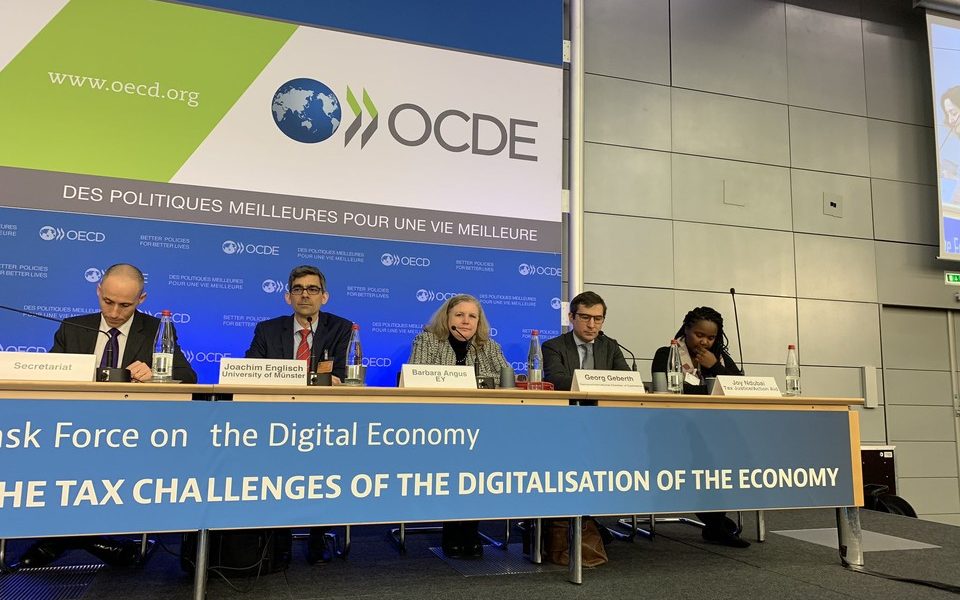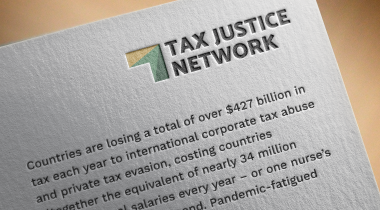
Mark Bou Mansour ■ Addressing the tax challenges of the digitalisation of the economy: our submission to OECD consultation

Joy Ndubai, Global Tax Advisor at ActionAid Denmark today presented at the OECD in Paris on behalf of Tax Justice Network (among others) – you can watch her contribution (starting from 32:22 to 38:02) and the full discussion here or we have a clip of her speaking just below. Her full slides are available here. The text below is the full submission of the Tax Justice Network to the consultation (available as pdf, here). The full OECD consultation document containing the proposals to which our submission is responding, is available here.
Context for finally revisiting the arm’s length principle
In early 2013, the G20 group of countries gave a mandate to the OECD to reform the international rules for taxing multinational companies. For a brief period, the Base Erosion and Profit Shifting initiative (BEPS) seemed to open the door to revisit the decisions taken in the 1920s and 1930s at the League of Nations, which underpin the current rules. But the door was swiftly slammed shut by major OECD member states, and the BEPS Action Plan signed off later in the year was reduced to a defence of the status quo, with a range of patches to be added.
The League of Nations had presided over a debate between two main competing alternatives for the taxation of multinational groups of companies. One, the unitary approach, assesses multinationals’ total profits at the unit of the group, and then apportions that between the various countries of operation, in line with the share of economic activity in each. A formula for that apportionment could take into account, for example, each country’s share of a multinational’s total sales and total employment. The formula could be set globally (as is the case for the unitary approach operated by the provinces of Canada), or by individual jurisdictions (as is the case for the unitary approach operated by the states of the USA).
The League of Nations chose instead the separate accounting approach. In contrast, this assesses profits in each entity that is part of a multinational – separately. The key to this approach is to ensure that entities within the same multinational group trade with each other at market prices, as if they were independently profit maximising. As long as ‘transfer prices’ adhere to this arm’s length principle, taxable profits are said to be allocated appropriately.
The arm’s length principle is economically illogical, because the rationale for multinational groups to exist is that they can outcompete separate entities doing the same business. In other words, multinationals can make higher profits than a set of entities operating at arm’s length from each other, so that ‘true’ transfer prices for a multinational cannot be the same as arm’s length prices. If this is not the case in a given market, multinationals should be outcompeted and so will not exist (nor have any profits to tax).
In practice, the approach provides enormous scope for profit shifting. There are multiple recognised approaches to determine arm’s length prices under the OECD rules, and of course companies and their tax advisers will use the full range of possibilities to determine the outcome they wish. If that can’t be done legally, it turns out that misrepresenting the true prices is also very common. As the UK tax authority, Her Majesty’s Revenue and Customs (HMRC), put it at the start of this year:
Our investigations into Profit Diversion to date have established that in a large number of cases the factual pattern outlined to HMRC at the start of an enquiry does not stand up to scrutiny once tested. That may be a result of a careless error (for example individuals within a group being unaware of what the actual facts are) but it may also be a result of a deliberate behaviour, that is a group knowingly submitting a [transfer pricing] methodology in a Corporation Tax Return based on a false set of facts. A common issue is an overstatement of functions performed, assets used and risks assumed in entities taxed at lower rates, and an understatement of the functions performed, assets used and risks assumed in the UK.
The unitary approach recognises the economic unit at which profit is maximised in reality, which is the group as a whole. If there were global agreement on the apportionment formula, it would be possible to guarantee no double taxation and also no double non-taxation: precisely 100% and no more of a multinational’s profits would be allocated as tax base somewhere.
If individual countries were to use their own formula (e.g. with some putting more weight on employment, or more weight on sales), the situation would be closer to the current experience where there is great variation in the national application of the arm’s length principle: that is, with scope for both double taxation and double non-taxation. But under a unitary approach that scope would at least be transparent.
The complexity of current arrangements means only the outcome of arbitrage between different tax systems is observable. And what is observed is a massive misalignmentbetween the location of multinationals’ real economic activity, and where their profits are declared for tax purposes. The OECD has estimated the annual revenue losses at between $100 billion and $240 billion a year. Researchers at the International Monetary Fund use a more rigorous methodology to estimate losses of $600 billion a year. We use this methodology with a more robust dataset to estimate losses of $500 billion a year.
The results are consistent in showing that the biggest losers in absolute terms are major, high-income countries; while the biggest losers in terms of the share of tax revenues lost, and therefore the likely human cost, are lower-income countries. Just a handful of jurisdictions are responsible for the great majority of the losses suffered by all others, including the Netherlands, Ireland, Luxembourg, Bermuda, Cayman, Switzerland and Singapore.
The single goal of the BEPS process was to reduce this misalignment between real activity and profits – implying a major reduction in the global inequalities in taxing rights that persist under the separate accounting approach. But when the Action Plan was published, it was clear that member states’ desire to retain the status quo had set the OECD an impossible task. Instead, BEPS was set up to become, we predicted, the last great, and failed, defence of the arm’s length principle. And so it has been.
There is now widespread recognition that BEPS has failed to curtail multinational tax avoidance to a significant degree – and that this failure was largely inevitable from the moment that OECD member states insisted on maintaining the arm’s length principle as the basis for international tax rules. Barely was the ink dry on the final BEPS report published in 2015, when the US had entered policy dialogue about the major 2017 reform that goes far beyond the arm’s length principle; and the EU had renewed its intention to introduce a unitary approach through the Common Consolidated Corporate Tax Base proposals.
These radical reforms – the very ones that these major OECD members had prevented being considered in the BEPS process – now informed competing proposals for the thorniest issue left untouched by BEPS. As the newly announced consultation terms it, this is ‘The Tax Challenges of the Digitalisation of the Economy’. Nowhere are the weaknesses of the arm’s length principle more clearly laid bare than where services in one economy are delivered through virtual platforms located in others, or perhaps nowhere for tax purposes, allowing blatant double non-taxation.
The multiple avenues for progress raised in the consultation, and the multiple areas in which the scope may be limited, make it imperative that there is full transparency of the rules and their outcomes. That means going beyond the OECD commitment to deliver highly aggregated data from multinationals’ country-by-country reporting, and meeting the original intention of this Tax Justice Network: full public reporting by multinationals. Without full transparency of the eventual alignment (or otherwise) of declared profits with real economic activity, progress will be fleeting at best. Tax justice, like all justice, must not only be done but be seen to be done.
In addition, the substantial technical flaws in the OECD country-by-country reporting standard must be urgently addressed. The leading global sustainability standard setter, the Global Reporting Initiative (GRI), now has a draft standard for reporting tax and payments to government, which addresses key weaknesses of the OECD standard, and should be considered as the basis for convergence.[1]
Considerations of the consultation’s role and pillars
It is a major breakthrough that international tax rules are being discussed overtly in terms of the distribution of taxing rights between different types of economies. This is a very welcome move beyond the BEPS pretence that the systemic, global tax abuse of multinationals raise only technical questions. The decisions taken at the League of Nations, and the OECD’s subsequent overseeing of the rules have been fundamentally political – as are the resulting inequalities in the distribution of taxing rights.
The major OECD members now face a number of decisions. At the simplest level, Pillar 1 of the consultation relates to the necessarily complex series of questions within the BEPS ‘digitalisation’ process. Positions must be taken, first, on the scope of the exercise: will there be an attempt to limit it to some ‘digital services’ companies, however these would be defined; or will it be accepted that the principles in play should apply across the board, just as the new opportunities to circumvent arm’s length pricing do? It seems clear that the scope must be broad.
Next, positions must be taken on the extent of profit that should be apportioned: will this apply to all profits, i.e. a full unitary approach, or only to some ‘residual’ or excess profit somehow calculated and deemed to have no arm’s length allocation. And then the apportionment itself: what is the economic activity with which profit should be aligned? Some have argued for only considering final sales, which would probably represent an improvement on the status quo but would lock in a powerful bias in favour of the major market economies. Others including the Tax Justice Network have emphasised the importance of reflecting the location of employment also, to reduce the bias against producer countries.
The shift to openly discussing the allocation of taxing rights will also change the way outcomes are evaluated. The BEPS process manifestly failed to address the glaring inequalities, but to a degree this could be framed as ‘only’ a technical or process failure. A failure to resolve a question posed in terms of different countries’ taxing rights cannot be seen as anything other than political.
As a result, any outright dispute that saw major OECD members align, in order to overcome common Inclusive Framework positions, would be politically explosive. First, such a result would immediately be seen as illegitimate. The space would be wide open for individual countries to impose fairer, transparent apportionment formula to protect their own taxing rights.
Second, the OECD itself would be overtaken by the same clarity of the outcome’s illegitimacy. There would be a step change in support for a UN body to take the responsibility for international tax rules from the OECD. Resistance from OECD members, which to date has been cloaked in a preference for the technical capacity and streamlined decision-making of the OECD, would be revealed as purely concerned with protecting power.
It is impossible to say where the global governance of tax would end up in this scenario, but it seems clear that the process of stripping the OECD’s disproportionate power over international tax would be greatly accelerated. OECD members face a difficult question if such a dispute arises, since protecting their immediate power may turn out to be the most pyrrhic of victories.
An alternative scenario could see OECD members remain divided, and some of them form a coalition with leading players in the Inclusive Framework such as the G-24 group of countries. There is clear scope for agreement on a broad apportionment basis that is revenue-protecting for the great majority of countries, since only a handful of profit-shifting jurisdictions benefit at the expense of all others. Such an outcome could provide the stable, long-term basis for international tax that has now been lacking for many years. It could even promote OECD legitimacy as a forum for the future.
Pillar 2, meanwhile, seeks to “strengthen the ability of jurisdictions to tax profits where the other jurisdiction with taxing rights applies a low effective rate of tax to those profits”. At issue is whether to support the tax sovereignty of those that suffer profit shifting, by drawing a line under the extent to which multinationals can reduce their overall tax contribution. The counter-argument has long been that minimum tax rates undermine the sovereignty of those jurisdictions that wish to attract investment through a race to the bottom – but the evidence is very clear that shifts in real activity are marginal, compared to the illicit flows that the Netherlands, Bermuda and others attract by allowing real effective tax rates at or near zero.
It is possible that OECD members revert to protecting those near-zero rates, in response to the siren song of their own multinationals’ lobbying (and the evidence-free ideological claims for unregulated tax ‘competition’), and this could again result in major conflict with lower-income countries that suffer disproportionately the costs of profit shifting. But an alternative scenario, of broad support for minimum rates, is less unlikely than at any previous point in OECD debates.
Revised profit allocation and nexus rules
As for the comparative merits between the three outlined proposals to establish nexus and allocate profit, the only approach enabling not only the apportionment of some portion of a multinational group’s profits (either all residual or non-routine profits, or only those resulting from marketing intangibles) but the entire group’s profits, is the “significant economic presence” proposal.
Therefore, conscious of the need to revise the profit allocation and nexus rules not only with respect to the digital economy, we endorse that latter approach above all of the alternatives. Simplicity and relative ease of verification of observable and measurable phenomena is another strong argument in favour of the significant economic presence threshold compared to the other proposals, which depend to a larger degree on analyses of a group’s internal designation of functions and legal arrangements, and are thus more easily manipulated for tax avoidance purposes.
Only this proposal has the potential to live up to the intentions of and mandate the G20 gave the OECD in 2013 to present proposals that would better align profits with economic activity, as it enables establishing nexus not only with respect to production, but also with respect to sales. Sales are an integral part of economic activity of any business. This proposal also has the potential to help overcoming the incentives for splitting activities under “stripped risk” considerations under the separate entity principle.
Inherent potential to enable robust unilateral anti-erosion policies
Fundamentally, the proposal of a significant economic presence nexus carries the built in possibility for jurisdictions to unilaterally enact an alternative minimum tax based on formulary apportionment, as discussed ad 3.4 below. This is because profit apportionment is allowed under many, if not most of the existing bilateral double tax avoidance treaties. This profit apportionment is currently allowed under United Nations Model Tax Convention Art. 7.4, and it was allowed under OECD Model Tax Convention up until the revision in 2010. Article 7.4 of the UN Model Tax Convention currently states:[2]
“4. In so far as it has been customary in a Contracting State to determine the profits to be attributed to a permanent establishment on the basis of an apportionment of the total profits of the enterprise to its various parts, nothing in paragraph 2 shall preclude that Contracting State from determining the profits to be taxed by such an apportionment as may be customary; the method of apportionment adopted shall, however, be such that the result shall be in accordance with the principles contained in this article.”
This provision has the potential to act as a powerful backstop to aggressive tax avoidance depleting the coffers of many countries worldwide, as Article 7.4 allows to take into account group wide profits for taxation in situations in which the tax base of permanent establishments have been subject to manipulation or are subject to dispute or doubt.
The relevance of this potentially very powerful provision, however, depends entirely on the definition of a permanent establishment. As the BEPS monitoring group has argued, the changes to the permanent establishment concept discussed above and proposed by the OECD might not be effective in limiting very substantial avoidance of PE by multinational companies operating in the domestic economy. As a remedy this risk, the BMG suggested the introduction of an adjusted PE concept, or of a new concept of a “significant presence” to replace, complement or inform the permanent establishment definition.
The following criteria have been proposed as the basis of a significant presence of a multinational company by the BEPS monitoring group:
“(a) relationships with customers or users extending over six months, combined with some physical presence in the country, directly or via a dependent agent;
(b) sale of goods or services by means involving a close relationship with customers in the country, including (i) through a website in the local language, (ii) offering delivery from suppliers in the country, (iii) using banking and other facilities from suppliers in the country, or (iv) offering goods or services sourced from suppliers in the country;
(c) supplying goods or services to customers in the country resulting from or involving systematic data–gathering or contributions of content from persons in the country.” [3]
By incorporating these requirements as a basis of an adjusted definition of a permanent establishment, the widespread avoidance of permanent establishments by highly profitable international corporations could be legally challenged. As has been widely reported for the case of Apple, this corporation has been ruled to pay an additional 13 billion of Euros in corporate taxes to the Irish government. But EU Commissioner Margaret Vestager responsible for that decision made clear that the respective revenue losses are very likely not to be affecting Ireland or Europe alone, but to extend to African countries as well. Given that this strategy to avoid a PE is likely to be replicated by the companies of many capital exporting nations, including by many German corporations involved in engineering, manufacturing, chemicals etc, substantial revenue can be expected to be at stake.
However, before taxation of the profits derived from sales becomes feasible in the market jurisdiction, a third prerequisite needs to be fulfilled. If the criteria laid down above to determine a significant presence cannot be checked and the rules cannot be enforced, the system fails. Without the identification of the companies that are routing sales to a particular country while avoiding a permanent establishment, the definition of a significant presence cannot be applied. Even if local registration requirements for legal entities, branches and other related parties are enforced in the respective country, local accounts or tax returns will normally not show the profits derived from local sales or service provision if a multinational enterprise is intent on avoiding a permanent establishment.
The significant economic presence approach should therefore be accompanied by a robust local filing requirement for country by country reports in order to help discovering sales unrecorded by local accounts, providing the necessary identification of the companies in question. Country by Country reporting is mandatory under BEPS Action 13, but the OECD requires a very restricted, cumbersome and complex local filing requirement.
Because of these hurdles which may result in failure to obtain CBCR reports especially by lower and middle income countries, even OECD countries have chosen to implement a more robust local filing requirement for CBCR reports, including countries such as France, Germany and Spain.[4] The implementation of robust local filing requirements thus is a third condition for effectively taxing multinationals that seek to avoid permanent establishments.
Therefore, we support the approach the OECD presented on introducing a significant economic presence, emphasizing the need to ensure possibilities to verify the thresholds chosen for determining a significant economic presence. As the maximum, we recommend that one single of the three criteria mentioned as criteria for a “significant presence” by the BEPS monitoring group suffices for establishing a significant economic presence.
Centrality of the wide definition of the group or “enterprise”
To ensure the feasibility and sustainability of the significant economic presence approach, consideration should be given to the definition of the scope of the multinational company group (or “enterprise” as per Art. 7.4, see above).
First, upwards and downwards, and indirect and direct shareholdings should equally be considered for group membership. Secondly, instead of establishing a specific percentage threshold of shareholdings or control for defining the membership of any subsidiary in a group, the extent of including a subsidiary into the group should be determined by the percentage share directly or indirectly controlled or owned by other group members. If a subsidiary is making 100 profits and 50% of its shares are controlled by a group, half of that subsidiary’s profits should be included in the group’s profit for formulary apportionment. Thirdly, a group should by default always extend to include any third party legal entities to which there are business to business sales, with the burden of proof on the third party to show that it only derives a certain percentage of its own sales revenue from selling on the products of the group to either other businesses (BTB) or natural person customers (BTC). That percentage would then be used to determine that third party’s profits inclusion in the tax base of the group. These rules would constitute the core for countering tax avoidance structures of group wide formulary apportionment.
Without such a provision, there is a risk that groups would seek to minimize group profits and avoid tax by devolving sales functions to “independent” commissionaires.
Centrality of a robust tax accounting standard
The feasibility and sustainability of allocating profits to a significant economic presence based on fractional or formulary apportionment may hinge on a robust definition of the tax base, and the allocation keys. If, as contemplated in paragraph 53 of the consultation document, the tax base was determined by applying the global profit rate of the MNE group to the revenue (sales) generated in any particular jurisdiction, one crucial caveat has to be kept in mind.
The global profit for determining the global profit rate should be derived from the public consolidated financial statements that corporations publish and present to shareholders and/or owners; and should not be derived by adding up the profits captured by the CBCR reports. In this way, at least for publicly listed companies, the highest level of profits the group is intent on showing to shareholders, would be split and subject to tax. Per the draft GRI standard, reporters should be required to reconcile any differences.
For other, unlisted companies, and especially for some so-called family businesses with many billion Euros in turnover, additional consideration should be given to the correct determination of the actual profit. In Germany, for example, even extremely large companies may not be required to include their group wide consolidated profits in their financial statements, but turnover only. To remedy this secrecy, it would be important to accompany the introduction of the significant economic presence with a requirement to publish country by country reports for very large multinational groups, no matter how they are owned and independent of their listings on a stock exchange. The extreme lobby powers of German family businesses to defend the secretive status quo should not be underestimated. We have recently documented the disproportional influence German businesses and the German government have wielded in Europe over the last 40 years to protect corporate secrecy.[5]
While corporate country by country transparency would go some way in preventing and/or disclosing tax avoidance resulting from the manipulation of the allocation keys, further consideration should be given to the experiences and discussions around the introduction of a common consolidated corporate tax base in the European Union. Most importantly, if the allocation key was to include capital, a number of extremely complex accounting problems would arise. The unsuitability of the existing financial reporting standards, exacerbated by the co-existence of a wide variety of national rules, for deriving robust valuations of capital assets has been subject to thorough analyses by researchers in 2015.[6] Current accounting rules allow a multiplicity of valuations of assets, which would result in indeterminacy of and easy-to-manipulate capital assets. The complexities, both technical and political, for deriving a workable tax accounting standard that would overcome these difficulties are enormous, and unlikely to be successfully overcome.
The other two factors appear more easy to account for. Therefore, we recommend an allocation key of the profits under the significant economic presence approach that includes employment (full time equivalents) and sales (destination basis).
Global anti-base erosion proposal
Ad 3.3: Income inclusion rule
The income inclusion rule would appear to be a variant of CFC rules, although they are construed so as to operate in parallel. However, we are sceptical about the prospects of determining with legal certainty and robustness whether income was/not subject to tax at a minimum rate, unless the rules for the tax base are elaborated, and unless the rules would also apply to entities of a multinational group not only “downstream”, but also “upstream”. We are in particular sceptical about the feasibility of devising a robust enough “effective tax rate test”.
A recent working paper by the OECD points to the wide range of potential approaches and parameters[7], and thus illustrates the potential for contested or contradictory findings, including for the concomitant risk of legal disputes and lack of enforceability of the test’s determinations. The wide range of parameters to calculate effective tax rates and potential outcomes under this proposal is reminiscent of the inconsistency, complexity and often conflicting or arbitrary outcomes of the five or more transfer pricing methodologies.
Instead, the income inclusion rules could be elaborated further so as to result in an alternative minimum tax with formulary apportionment (FAMICT), as proposed by Tax Justice Network and supported by ICRICT. Under their proposal, a FAMICT would implement:
“[…]formulary apportionment as part of a domestic alternative minimum tax regime. In such a regime, formulary apportionment would determine the income base for computing an alternative minimum corporation tax.
The country could define the local corporation tax base by applying a multi-factor formula to a MNE’s global income, and compute the minimum tax payable on that apportioned income, for example at 80 percent of the regular corporation tax rate. The minimum tax would be payable if it exceeds the jurisdiction’s regular corporation tax payable computed on the MNE’s local income as determined under conventional arm’s-length transfer pricing methods.” [8]
The feasibility and sustainability of this measure will depend on the availability of robust country by country financial reporting data. The robustness of these country by country reports in turn ultimately hinges upon their public availability, and upon the possibility for public reconciliation with published consolidated financial statements.[9]
Ad 3.4: Tax on base eroding payments
Both proposed rules appear to require the introduction of additional red tape to be enforceable, and their effectiveness would hinge to a large extent upon administrative capacity in the jurisdiction that wishes to challenge low taxation in another state. As such, these proposals would change little about, and risk reinforcing, fundamental differences in the prospect for and outcomes of challenges to base erosion and profit shifting that are resulting from asymmetries in administrative capacity between many high-income countries on the one hand, and all other countries. These asymmetries today already result in inequalities in revenue collection capacities. Therefore, these proposals ultimately risk jeopardizing the fulfilment of basic human rights obligations (such as the rights to health and education, and women’s right to nondiscrimination) that governments of many lower-income countries – and others – are facing. As is the case today already in some jurisdictions for some specific payment types, outbound intra-group payments should be entirely disallowed for tax deductions. A Tax Justice Network briefing elaborates on that point, and more country-level research will be published shortly as part of the Corporate Tax Haven Index.[10]
[1] https://www.globalreporting.org/standards/work-program-and-standards-review/disclosures-on-tax-and-payments-to-government/
[2] https://www.un.org/esa/ffd/wp-content/uploads/2018/05/MDT_2017.pdf
See pages 6-8, in: https://bepsmonitoringgroup.files.wordpress.com/2014/04/bmg-digital-economy-submission-2014.pdf; 6.3.2019.
[4] https://www.financialsecrecyindex.com/PDF/9-Corporate-Tax-Disclosure.pdf; 6.3.2019.
[5] Alex Cobham, Petr Janský and Markus Meinzer, ‘A Half-Century of Resistance to Corporate Disclosure’, TRANSNATIONAL CORPORATIONS – INVESTMENT AND DEVELOPMENT, Special Issue on Investment and International Taxation. Part 2, 25/3 (2018), 1–26 <https://unctad.org/en/PublicationsLibrary/diaeia2018d5_en.pdf> [accessed 24 January 2019].
[6] Richard Murphy and Prem Sikka, Unitary Taxation: Tax Base and the Role of Accounting, ICTD Working Paper 34 (Brighton, 2015) <www.ictd.ac/ju-download/file/27-ictd-wp34-pdf/latest/download?12099bbf59da172b5ed8f526287ae100=1&return=aHR0cCUzQSUyRiUyRnd3dy5pY3RkLmFjJTJGanUtZG93bmxvYWQlMkYyLXdvcmtpbmctcGFwZXJzJTJGMjctdW5pdGFyeS10YXhhdGlvbi10YXgtYmFzZS1hbmQtdGhlLXJvbGUtb2YtYWNjb3VudGluZw==> [accessed 3 July 2016].
[7] Tibor Hanappi, Corporate Effective Tax Rates: Model Description and Results from 36 OECD and Non-OECD Countries, OECD Taxation Working Papers, 2018 <https://www.oecd-ilibrary.org/taxation/corporate-effective-tax-rates_a07f9958-en> [accessed 6 March 2019].
[8] Independent Commission for the Reform of International Corporate (ICRICT) and Taxation, A Roadmap To Improve Rules for Taxing Multinationals. A Fairer Future For Global Taxation, 2018, 11–12 <https://static1.squarespace.com/static/5a0c602bf43b5594845abb81/t/5a78e6909140b73efc08eab6/1517872798080/ICRICT+Unitary+Taxation+Eng+Feb2018.pdf> [accessed 21 February 2018].
[9] Alex Cobham, Petr Janský and Markus Meinzer, ‘A Half-Century of Resistance to Corporate Disclosure’, TRANSNATIONAL CORPORATIONS – INVESTMENT AND DEVELOPMENT, Special Issue on Investment and International Taxation. Part 2, 25/3 (2018), 1–26 <https://unctad.org/en/PublicationsLibrary/diaeia2018d5_en.pdf> [accessed 24 January 2019].
[10] https://taxjustice.net/wp-content/uploads/2017/11/Dodging-taxes-with-debt-TJN-Briefing.pdf; 6.3.2019.
Related articles
One-page policy briefs: ABC policy reforms and human rights in the UN tax convention

Bad Medicine: A Clear Prescription = tax transparency
Tax justice pays dividends – fair corporate taxation grows jobs, shrinks inequality

Reclaiming tax sovereignty to transform global climate finance
Reclaiming tax sovereignty to transform global climate finance
16 June 2025

The “millionaire exodus” visualised
The millionaire exodus myth
10 June 2025

The Financial Secrecy Index, a cherished tool for policy research across the globe

When AI runs a company, who is the beneficial owner?
Insights from the United Kingdom’s People with Significant Control register
13 May 2025

